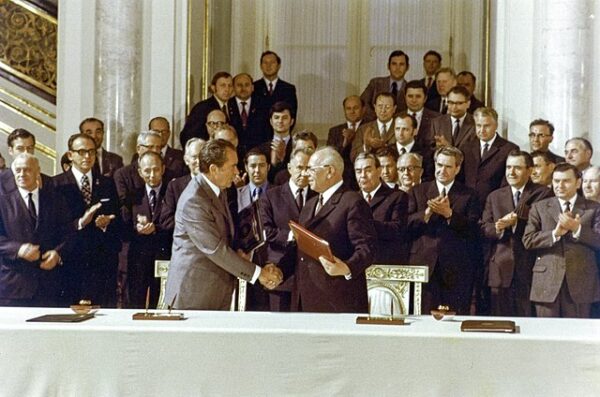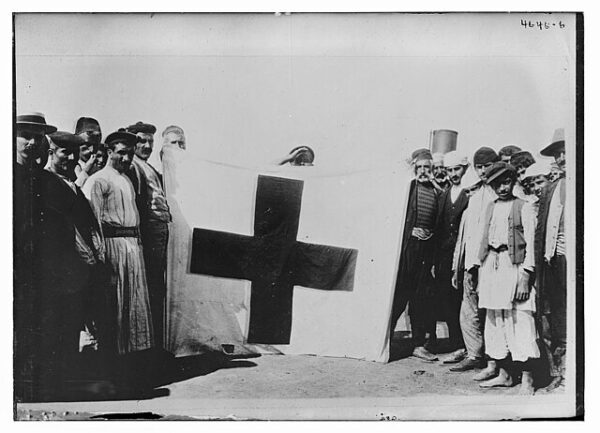On June 27, 1974, President Richard M. Nixon arrived in Moscow for what would be his final summit with Soviet leader Leonid Brezhnev—a visit overshadowed by scandal at home and a shifting geopolitical order abroad. Though the meeting marked a continuation of the historic thaw in Cold War tensions known as détente, Nixon’s political standing was badly weakened by the Watergate crisis. What had once been a bold diplomatic venture to recalibrate the Cold War balance was, by 1974, increasingly seen as a tenuous and embattled exercise in damage control.
This trip marked Nixon’s second visit to the Soviet Union, following his landmark 1972 summit in Moscow, during which the two superpowers signed the first Strategic Arms Limitation Treaty (SALT I) and the Anti-Ballistic Missile Treaty—cornerstones of the détente policy. These agreements had signaled a shared interest in avoiding nuclear confrontation and reducing military expenditures. But two years later, the context was starkly different. The U.S. was reeling from the twin traumas of the Vietnam War and the Watergate scandal, while the Soviet Union was facing economic stagnation and mounting pressure from its Eastern Bloc satellites. For both leaders, diplomacy was as much a public relations strategy as it was a matter of grand strategy.
Nixon landed in Moscow not as the triumphant statesman of 1972 but as a president facing almost certain resignation. His authority in Washington had eroded rapidly in the wake of the House Judiciary Committee’s impeachment hearings, which were in full swing by the time of the summit. Congressional leaders, journalists, and foreign governments alike viewed the trip as a last attempt by Nixon to project an image of international leadership and relevance. Yet Brezhnev, ever the realist, welcomed Nixon warmly, understanding that any agreements struck could bind future U.S. administrations—especially if they served Soviet interests.
During the weeklong summit, Nixon and Brezhnev focused on a variety of issues, including arms control, trade, and scientific cooperation. The centerpiece of the talks was an effort to lay the groundwork for SALT II, which aimed to go beyond the limitations set in 1972 and reduce the number of multiple independently targetable reentry vehicles (MIRVs)—a rapidly advancing missile technology that threatened to destabilize the nuclear balance. Though no final treaty was signed, a joint communiqué expressed mutual intent to complete SALT II by 1975. Nixon, in his public statements, framed the summit as a reaffirmation of peace through strength and reason.
Other agreements were more concrete. The two leaders signed accords on environmental protection, energy development, and agricultural exchange. A new treaty on the prevention of accidental nuclear war aimed to improve communication and minimize the risk of a crisis escalating due to miscalculation. And in a symbolic gesture, the United States agreed to help the Soviets build a pipeline in Siberia—part of a larger strategy to expand trade despite the continuing U.S. embargo on many advanced technologies.
Still, the overall atmosphere was far less enthusiastic than in 1972. Gone were the elaborate banquets, extravagant pageantry, and widespread optimism. Soviet citizens were largely indifferent to Nixon’s presence, and American journalists covering the summit focused as much on Watergate as they did on foreign policy. Behind closed doors, Brezhnev reportedly expressed concern about Nixon’s ability to deliver on American commitments.
Indeed, less than six weeks after the summit, Nixon would resign from office—the only U.S. president ever to do so. His departure cast a long shadow over the promises made in Moscow and raised questions about the durability of détente. Though President Gerald Ford would continue the talks and ultimately sign SALT II in principle in 1979, the unraveling of U.S.-Soviet relations was already underway, accelerated by Soviet actions in Angola, the Helsinki Accords’ mixed reception, and the invasion of Afghanistan in 1979.
Nixon’s 1974 visit thus stands as both a high-water mark and a turning point. It was the last act of a president who had once reshaped Cold War diplomacy but whose domestic downfall undercut the very policies he had championed abroad. In retrospect, the Moscow summit of June 1974 was not a triumph but a twilight—one final gesture in a Cold War drama soon to take a darker, more confrontational turn.






